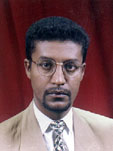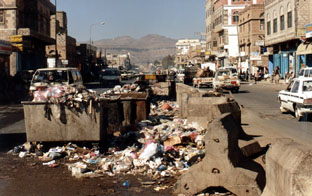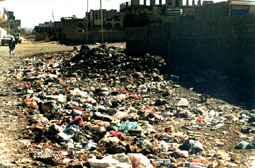
A WAKE UP CALL! [Archives:1998/50/Last Page]
December 14 1998

Hatem Bamehriz,
Yemen Times
There is a growing recognition of the fact that industrial progress is linked to a healthy environment. Safeguarding the environment represents a major challenge to the community (local & international). Handling hazardous wastes is an important part of this challenge.
What are hazardous wastes?
It is very difficult to define what hazardous wastes are. In a certain way, they are the by-product of modern technologies, a result of development.
Origins of hazardous wastes
In general, hazardous wastes mainly originate from industries that produce chemicals such as petrochemicals, paints, plastic, textiles, leather, etc.
Agriculture is considered another origin of hazardous wastes due to the use of pesticides, fertilizers and other chemicals.
Households and hospitals produce hazardous wastes such as garbage and pharmaceutical products.
In Yemen however, vehicles play an important role in producing hazardous wastes, because of the large quantities of used oil and the hazardous exhaust gases.
1. Industrial waste
Hazardous wastes in this category are usually chemical wastes. In other words, they are the remains of spills and leakage; row, rejected, and off-grade materials. A large amount of such wastes are dyes, pigments, paints, acids, batteries and insecticides. All these and more are dumped in large quantities, without any control.

2. Hospital waste
In all hospitals, wastes are collected in drums to be gathered by the municipalities and dumped in landfills. The separation of hazardous from non-hazardous waste does not happen in any of our hospitals. Separation could reduce the amount of hazardous waste by more than 90%, according to the World Health Organization (WHO).
Some hospitals burn the accumulated waste. Other hospitals have incinerators to burn solid waste, but have never used these facilities. Why?
The average solid waste production is around 635 kg/year for every hospital bed. We can imagine how much hospital waste is generated and disposed of in landfills. Some of this waste (e.g., disposable contaminated needles) are dumped on public roads, risking the lives of passers-by and municipality workers.
Chemical wastes from hospital laboratories, X-ray departments and blood banks are disposed of into the sewage. Among these are very toxic ones. Chemicals disposed of in large quantities are acids, alkalis and methyl blue.
3. Oil wastes
The transportation sector is the largest consumer of lubricant oil, compared to industries and agricultural sectors, which only consume around 15% of the total consumed oil. Enormous quantities of lubricant grease is released at service stations as waste. Some of that is reused as a fuel by cement factories, power stations and Turkish baths, etc.
The reuse of waste oil has declined due to the fact cement factories and power stations are lowering their consumption rates of it because of the impurities it includes. On the other hand, waste oil is not used as before by Turkish baths either, because they are on the verge of disappearing altogether.
4. Photographic wastes
In photo laboratories some chemicals are used to develop films and photos. Chemicals are used as fixers, developers, bleachers and stabilizers. Such chemicals are completely disposed of into the sewage. They are very harmful.

After we found out how hazardous wastes are generated, and before we discuss the best way to deal with this problem, we should ask ourselves: “Are we aware of the dimensions of this problem?”. Awareness is the first step to be taken in solving any problem.
The negative answer to this question is a shocking reality. People in Yemen are not quite aware of the presence of hazardous wastes. We, as citizens, are not even sure if there is a governmental department for supervising and controlling the amounts of these wastes.
While awareness in governmental ranks is weak, public awareness of the dangers of hazardous wastes does not exist at all. People do not realize how serious this issue is, including those working in chemical, textile and leather industries. Almost all factories in Yemen do not take occupational health or safety into consideration.
There is a general lack of personal protection against harmful wastes that workers are exposed to. For example, factories in Yemen do not provide enough protective clothing such as safety shoes, helmets, goggles, ear plugs, dust masks, etc. Therefore, the level of health problems and fatal injuries among workers is unacceptably high.
Usually the factory management is unaware of the danger of hazardous wastes and feels not responsible for the harm that may be caused to workers by the factory’s wastes. Disposing of chemicals into the sewage is the result of ignorance, lack of awareness, management being uninterested in the well-being of the workers, and insufficient government control.
Recommendations
There are many recommendations on how to prevent or reduce the suffering caused by hazardous wastes. According to experts, the problem is still in its early stages and can be controlled. However, in the near future it may grow and become difficult to solve. Experts further warn that if the problem is ignored for a long time, it will probably get out of control causing disastrous results to the environment.
Here are some of the recommendations made by people who had studied these cases to help us avoid a tragedy:
– Collection of these wastes and safe disposal or incineration is the most generally recommended treatment. Usually special designs of incinerators are used, known as controlled-air incineration. This incineration emits very low amounts of CO2, particles, odors or visible emissions. The fact that most industries are located in one of the four large cities in Yemen makes collecting and safe disposing of waste easier.
Oil waste must be collected and stored safely to be disposed of, incinerated or reused by power stations.
Sometimes there are possible ways to recycle some hazardous wastes. In this case, separating hazardous from non-hazardous wastes is required.
S.O.S
The most common excuse we often hear from the authorities is “What can we do? we don’t have sufficient financial backing “. No matter how much costly it might be, we should always put in mind that humans are the most valuable resource the country has, and they should be safeguarded and protected in every possible way.
It is time for us to wake up, the problem is not yet too complicated to be solved and is still under control. We currently have a chance to prevent a gigantic calamity. There are small problems, which, if not solved in time, may become big problems that we might find too difficult – if not impossible- to solve. Hazardous waste belongs certainly to this category.
Sources – UN. & W. H. O.
——
[archive-e:50-v:1998-y:1998-d:1998-12-14-p:./1998/iss50/lastpage.htm]


